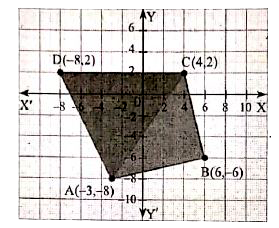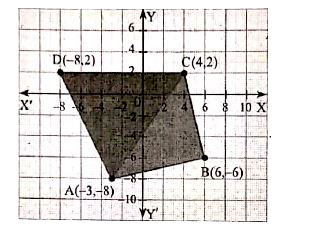The points A,B,C,D have the respective coordinates (-2,-3),(6,-5) , (18,9) and (0,12) . Find the area of the quadrilateral ABCD.Solution in Bengali
The correct Answer is:=206 square unit.
Step by step video, text & image solution for The points A,B,C,D have the respective coordinates (-2,-3),(6,-5) , (18,9) and (0,12) . Find the area of the quadrilateral ABCD. by Maths experts to help you in doubts & scoring excellent marks in Class 12 exams.
Topper's Solved these Questions
- BOOK - CHHAYA PUBLICATIONCHAPTER - REVISION OF PREVIOUS TWO DIMENSIONAL COORDINATE GEOMETRY EXERCISE - EXERCISE 1 (MCQ)30videos
REVISION OF PREVIOUS TWO DIMENSIONAL COORDINATE GEOMETRY
- BOOK - CHHAYA PUBLICATIONCHAPTER - REVISION OF PREVIOUS TWO DIMENSIONAL COORDINATE GEOMETRY EXERCISE - EXERCISE 1 (Very Short Type Questions )41videos
REVISION OF PREVIOUS TWO DIMENSIONAL COORDINATE GEOMETRY
- BOOK - CHHAYA PUBLICATIONCHAPTER - RELATIONSEXERCISE - Sample Question for Competitive Examination (Assertion -Reason Type )2videos
RELATIONS
- BOOK - CHHAYA PUBLICATIONCHAPTER - SECOND ORDER DERIVATIVEEXERCISE - Sample Question for Competitive Examination (Assertion-Reason type)2videos
SECOND ORDER DERIVATIVE
Similar Questions
The abscissa of any point on y -axis is -
07:11View SolutionThe sides of the rectangle ABCD are parallel to the coordinate axis. If the coordinates of the vertices B and D be (7,3) and (2,6) respectively, find the coordinates of the vertices A and C .
06:06View SolutionEach question in this section has four choices A , B, C , and D out of which only one is coR Rect. Mark your choices as follows .
Let R be a relation on the set NN of the natural numbers defined by nRm <⇒ n is a factor of m.
Statement -1 : R is not oan equivalence relation.
Statement -II: R is not symmetric05:25View SolutionGiven, x2+y2=1. Y' and y'' are first and second order derivative of y respectively.
Statement-I 1+yy''+(y')2=0
Statement- II xx'+2y=004:04View SolutionIf A(−5, 7), B(−4, −5), C(−1, −6) and D(4, 5)are the vertices of a quadrilateral, find the area of the quadrilateral ABCD.
04:56View Solutionयदि A(-5,7), B(-4,-5), C(-1, -6) और D(4,5) एक चतुर्भुर्ज ABCD के शीर्ष हैं, तो इस चतुर्भुर्ज का क्षेत्रफल ज्ञात कीजिए |
08:34View SolutionIf A(-7, 5), B(-6, -7), C(-3, -8) and D(2, 3) are the vertices of a quadrilateral ABCD then find the area of the quadrilateral.
02:41View Solutionयदि A(−5,7),B(−4,−5),C(−1,−6) और −D(4,5)एक चतुर्भुज ABCD के शीर्ष बिन्दु है तो चतुर्भुज ABCD का क्षेत्रफल ज्ञात कीजिए ।
02:35View Solutionयदि A(-5,7), B(-4,-5), C(-1,-6), और D(4,5) एक चतुर्भुज ABCD के शीर्ष हैं, तो इस चतुर्भुज का क्षेत्रफल ज्ञात कीजिये।
02:40View SolutionA(-4, 8), B(-3, -4), C(0, -5) और D(5, 6) शीर्ष वाले चतुर्भुज ABCD का क्षेत्रफल ज्ञात कीजिए ।
09:30View SolutionGiven a quadrilateral ABCD with vertices A(-3,-8),B(6,-6),C(4,2) and D(-8,2).

Find the area of △ABC .03:33View SolutionGiven a quadrilateral ABCD with vertices A(-3,-8),B(6,-6),C(4,2) and D(-8,2).

Find the area of △ACD.06:00View SolutionGiven a quadrilateral ABCD with vertices A(-3,-8),B(6,-6),C(4,2) and D(-8,2).

Find the area of quadrilateral ABCD.04:30View SolutionIf A(-5, 7), B(-4,-5), C(-1, -6) and D(4,5) are the vertices of a quadrilateral, then, find the area of the quadrilateral ABCD.
02:45View SolutionIf A(-5, 7), B(-4,-5), C(-1, -6) and D(4,5) are the vertices of a quadrilateral, then, find the area of the quadrilateral ABCD.
05:39View Solution

